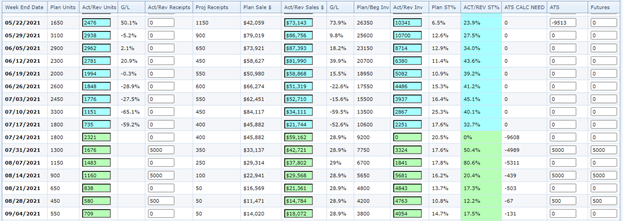By Jim Lewis, CEO Enhanced Retail Solutions LLC
Ladder plans, waterfalls, weekly planner- whatever you want to call them- should be a vital part of your inventory planning process. We call it Item Planner. It’s one of the most searched for and visited pages on our website. If you’re not familiar with any of these terms, let me acquaint you.
What Is An Item Plan?
An item planner is a tool that lets you plan sales, profit and inventory needs by week. It then tracks actuals against that plan and finally revises that original plan based on the trend. You can decide how many weeks to use to calculate the trend. It provides many benefits, especially in the upfront stages, forcing you to think about how an item will perform. The plan follows the entire lifecycle of the item- so you can carefully plan its demise in a smart way.
Tracking Performance
A good tool like ours (sorry, I couldn’t resist) adds a smack of intelligence. It doesn’t just bring in historic sales, it helps predict when sales will go up or down based on promotions, seasonality and other factors. It allows the user to conduct “what-if” scenarios so risk can be assessed. Let’s face it, inventory is capital, and everyone wants to have the highest sales while maintaining the lowest inventory levels possible. The weekly plan shows how much inventory is going to be needed each week- so you can flow out production in a reasonable manner. If an item does better than expected, and earns more inventory, or if it does worse than expected you will have excess inventory. The Planner will show you what the future inventory will look like in either case.

Item Planner (Ladder Planning) integrated with PowerBI
Assessing Risk on Margin Goals
Then there’s the profit issue. If an item doesn’t meet the retailer’s margin expectations, suppliers may be expected to share in the cost of a markdown. A supplier using an Item Planner who is tracking actuals against the plan every week should have no surprises. Every week after the actuals are updated, the Item Planner shows where you are on the profit line- and based on the trend, projects where the profit will be at the end of the plan. So, if it’s not on target, you can start taking action early to hopefully lessen the markdown impact.
It would be great to have an item plan for every SKU, but sometimes it’s just not possible. Make sure your key items are set up. You can even build multiple plans in the early stages of plan creation to determine what the profit will be at different costs and ticketed retails. Then layer on if an item does better than expected, or worse than expected what the impact on profit will be. It will even tell you the optimal price point for which the item makes the margin goal. That can be very helpful in negotiating the cost. To learn more, click here.
Want to recommend a topic? Take our survey.


Comments are closed